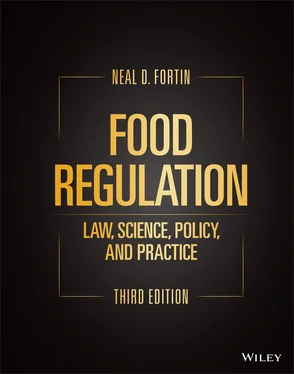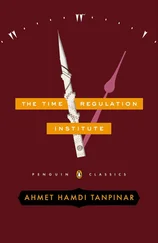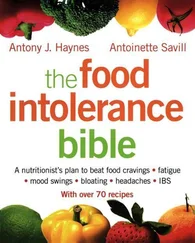Neal D. Fortin - Food Regulation
Здесь есть возможность читать онлайн «Neal D. Fortin - Food Regulation» — ознакомительный отрывок электронной книги совершенно бесплатно, а после прочтения отрывка купить полную версию. В некоторых случаях можно слушать аудио, скачать через торрент в формате fb2 и присутствует краткое содержание. Жанр: unrecognised, на английском языке. Описание произведения, (предисловие) а так же отзывы посетителей доступны на портале библиотеки ЛибКат.
- Название:Food Regulation
- Автор:
- Жанр:
- Год:неизвестен
- ISBN:нет данных
- Рейтинг книги:4 / 5. Голосов: 1
-
Избранное:Добавить в избранное
- Отзывы:
-
Ваша оценка:
- 80
- 1
- 2
- 3
- 4
- 5
Food Regulation: краткое содержание, описание и аннотация
Предлагаем к чтению аннотацию, описание, краткое содержание или предисловие (зависит от того, что написал сам автор книги «Food Regulation»). Если вы не нашли необходимую информацию о книге — напишите в комментариях, мы постараемся отыскать её.
Food Regulation: Law, Science, Policy, and Practice
Food Regulation: Law, Science, Policy, and Practice, Third Edition,
Food Regulation — читать онлайн ознакомительный отрывок
Ниже представлен текст книги, разбитый по страницам. Система сохранения места последней прочитанной страницы, позволяет с удобством читать онлайн бесплатно книгу «Food Regulation», без необходимости каждый раз заново искать на чём Вы остановились. Поставьте закладку, и сможете в любой момент перейти на страницу, на которой закончили чтение.
Интервал:
Закладка:
(1) articles used for food or drink for man or other animals, (2) chewing gum, and (3) articles used for components of any such article.
Section 321(g)(1)(C) was added to the statute in 1938 to expand the definition of “drug.” The amendment was necessary because certain articles intended by manufacturers to be used as drugs did not fit within the “disease” requirement of Section 321(g)(1)(B). Obesity in particular was not considered a disease. Thus “anti‐fat remedies” marketed with claims of “slenderizing effects” had escaped regulation under the prior definition. The purpose of part C in Section 321(g)(1) supra was “to make possible the regulation of a great many products that have been found on the market that cannot be alleged to be treatments for diseased conditions.”
It is well established that the definitions of food and drug are normally not mutually exclusive; an article that happens to be a food but is intended for use in the treatment of disease fits squarely within the drug definition in part B of Section 321(g)(1) and may be regulated as such. Under part C of the statutory drug definition, however, “articles (other than food)” are expressly excluded from the drug definition (as are devices) in Section 321(g)(1). In order to decide if starch blockers are drugs under Section 321(g)(1)(C), therefore, we must decide if they are foods within the meaning of the part C “other than food” parenthetical exception to Section 321(g)(1)(C). And in order to decide the meaning of “food” in that parenthetical exception, we must first decide the meaning of “food” in Section 321(f).
Congress defined “food” in Section 321(f) as “articles used as food.” This definition is not too helpful, but it does emphasize that “food” is to be defined in terms of its function as food, rather than in terms of its source, biochemical composition, or ingestibility. Plaintiffs’ argument that starch blockers are food because they are derived from food—kidney beans—is not convincing; if Congress intended food to mean articles derived from food it would have so specified. Indeed some articles that are derived from food are indisputably not food, such as caffeine and penicillin. In addition, all articles that are classed biochemically as proteins cannot be food either, because for example insulin, botulism toxin, human hair, and influenza virus are proteins that are clearly not food.
Plaintiffs argue that 21 U.S.C. § 343(j) specifying labeling requirements for food for special dietary uses indicates that Congress intended products offered for weight conditions to come within the statutory definition of “food.” Plaintiffs misinterpret that statutory Section. It does not define food but merely requires that if a product is a food and purports to be for special dietary uses, its label must contain certain information to avoid being misbranded. If all products intended to affect underweight or overweight conditions were per se foods, no diet product could be regulated as a drug under Section 321(g)(1)(C), a result clearly contrary to the intent of Congress that “anti‐fat remedies” and “slenderizers” qualify as drugs under that Section.
If defining food in terms of its source or defining it in terms of its biochemical composition is clearly wrong, defining food as articles intended by the manufacturer to be used as food is problematic. When Congress meant to define a drug in terms of its intended use, it explicitly incorporated that element into its statutory definition. For example, Section 321(g)(1)(B) defines drugs as articles “intended for use” in, among other things, the treatment of disease; Section 321(g)(1)(C) defines drugs as “articles (other than food) intended to affect the structure or any function of the body of man or other animals.”… . Further, a manufacturer cannot avoid the reach of the FDA by claiming that a product which looks like food and smells like food is not food because it was not intended for consumption… . In United States v. Technical Egg Prods., Inc ., the defendant argued that the eggs at issue were not adulterated food under the Act because they were not intended to be eaten. The court held that there was a danger of their being diverted to food use and rejected defendant’s argument.
Although it is easy to reject the proffered food definitions, it is difficult to arrive at a satisfactory one. In the absence of clear‐cut Congressional guidance, it is best to rely on statutory language and common sense. The statute evidently uses the word “food” in two different ways. The statutory definition of “food” in Section 321(f) is a term of art, and is clearly intended to be broader than the common‐sense definition of food, because the statutory definition of “food” also includes chewing gum and food additives. Food additives can be any substance the intended use of which results or may reasonably result in its becoming a component or otherwise affecting the characteristics of any food. Paper food‐packaging when containing polychlorinated biphenyls (PCBs), for example, is an adulterated food because the PCBs may migrate from the package to the food and thereby become a component of it. Yet the statutory definition of “food” also includes in Section 321(f)(1) the common‐sense definition of food. When the statute defines “food” as “articles used for food,” it means that the statutory definition of “food” includes articles used by people in the ordinary way most people use food—primarily for taste, aroma, or nutritive value. To hold as did the district court that articles used as food are articles used solely for taste, aroma or nutritive value is unduly restrictive since some products such as coffee or prune juice are undoubtedly food but may be consumed on occasion for reasons other than taste, aroma, or nutritive value….
This double use of the word “food” in Section 321(f) makes it difficult to interpret the parenthetical “other than food” exclusion in the Section 321(g)(1)(C) drug definition. As shown by that exclusion, Congress obviously meant a drug to be something “other than food,” but was it referring to “food” as a term of art in the statutory sense or to foods in their ordinary meaning? Because all such foods are “intended to affect the structure or any function of the body of man or other animals” and would thus come within the part C drug definition, presumably Congress meant to exclude common‐sense foods. Fortunately, it is not necessary to decide this question here because starch blockers are not food in either sense. The tablets and pills at issue are not consumed primarily for taste, aroma, or nutritive value under Section 321(f)(1); in fact, as noted earlier, they are taken for their ability to block the digestion of food and aid in weight loss. In addition, starch blockers are not chewing gum under Section 321(f)(2) and are not components of food under Section 321(f)(3). To qualify as a drug under Section 321(g)(1)(C), the articles must not only be articles “other than food,” but must also be “intended to affect the structure or any function of the body of man or other animals.” Starch blockers indisputably satisfy this requirement for they are intended to affect digestion in the people who take them. Therefore, starch blockers are drugs under Section 321(g)(1)(C) of the Food, Drug, and Cosmetic Act.
Affirmed.
* * * * *
2.3 THE CENTRAL ROLE OF INTENDED USE
In the Nutrilab starch blockers case, the manufacturer’s intent was clear. As was the fact that the product was not consumed for its taste, aroma, or nutritive value. Thus, starch blockers were deemed other than a conventional food.
The Nutrilab case provides one of the best rules for determining whether a product is a food or a drug. First ask, is the product a common‐sense food? If not, is it consumed primarily for taste, aroma, or nutrition? If the answer is no to both these questions, then the product may not be a food. There can be other factors, but this common‐sense rule still provides excellent guidance.
Читать дальшеИнтервал:
Закладка:
Похожие книги на «Food Regulation»
Представляем Вашему вниманию похожие книги на «Food Regulation» списком для выбора. Мы отобрали схожую по названию и смыслу литературу в надежде предоставить читателям больше вариантов отыскать новые, интересные, ещё непрочитанные произведения.
Обсуждение, отзывы о книге «Food Regulation» и просто собственные мнения читателей. Оставьте ваши комментарии, напишите, что Вы думаете о произведении, его смысле или главных героях. Укажите что конкретно понравилось, а что нет, и почему Вы так считаете.












